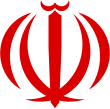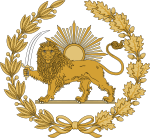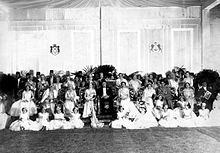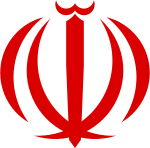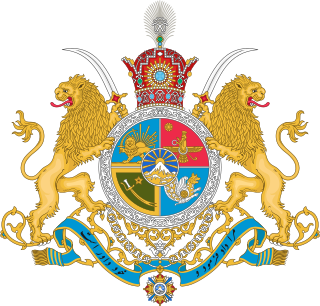
The Pahlavi dynasty was the last Iranian royal dynasty that ruled for roughly 53 years between 1925 and 1979. The dynasty was founded by Reza Shah Pahlavi, a non-aristocratic Mazanderani soldier in modern times, who took on the name of the Pahlavi language spoken in the pre-Islamic Sasanian Empire to strengthen his nationalist credentials.

The Iranian revolution, also known as the 1979 revolution, or the Islamic revolution of 1979 was a series of events that culminated in the overthrow of the Pahlavi dynasty in 1979. The revolution led to the replacement of the Imperial State of Iran by the present-day Islamic Republic of Iran, as the monarchical government of Mohammad Reza Pahlavi was superseded by the theocratic Ayatollah Ruhollah Khomeini, a religious cleric who had headed one of the rebel factions. The ousting of Pahlavi, the last Shah of Iran, formally marked the end of Iran's historical monarchy.

The national flag of the Islamic Emirate of Afghanistan, adopted on 15 August 2021 following the Taliban's victory in the 2001–2021 war, features a white field with a black Shahada inscribed. Since the 20th century, Afghanistan has changed its national flag several times. The national flag had black, red and green colors most of the time during the period.

The national flag of the Islamic Republic of Iran, also known as the Tricolour Flag of Iran, is a tricolour featuring the Pan-Iranian colors comprising equal horizontal bands of green, white and red with the national emblem (Allah) in red centred on the white band and the takbir written 11 times each in the Kufic script in white, at the bottom of the green and the top of the red band. After the Iranian Revolution of 1979, the present-day flag was adopted on 29 July 1980.

The prime minister of Iran was a political post that had existed in Iran (Persia) during much of the 20th century. It began in 1906 during the Qajar dynasty and into the start of the Pahlavi dynasty in 1923 and into the 1979 Iranian Revolution before being abolished in 1989.

Zulfaqar, also spelled Zu al-Faqar, Zulfakar, Dhu al-Faqar, or Dhulfaqar), is the sword of Ali ibn Abi Talib that was distinguished by having a double blade.

Derafsh Kaviani was the royal standard Derafsh of Iran (Persia) used since ancient times until the fall of the Sasanian Empire. The banner was also sometimes called the "Standard of Jamshid", the "Standard of Fereydun" and the "Royal Standard".

The double-headed eagle is an iconographic symbol originating in the Bronze Age. A heraldic charge, it is used with the concept of an empire. Most modern uses of the emblem are directly or indirectly associated with its use by the late Byzantine Empire, originally a dynastic emblem of the Palaiologoi. It was adopted during the Late Medieval to Early Modern period in the Holy Roman Empire, Albania and in Orthodox principalities, representing an augmentation of the (single-headed) eagle or Aquila associated with the Roman Empire. In a few places, among them the Holy Roman Empire and Russia, the motif was further augmented to create the less prominent triple-headed eagle.
Aryamehr was the title used in the Pahlavi dynasty by Shah Mohammad Reza Pahlavi of Iran. It means Light of the Aryans.
An Islamic flag is the flag either representing an Islamic Caliphate, religious order, state, civil society, military force or other entity associated with Islam. Islamic flags have a distinct history due to the Islamic prescription on aniconism, making particular colours, inscriptions or symbols such as crescent-and-star popular choices. Since the time of the Islamic prophet Muhammad, flags with certain colours were associated with Islam according to the traditions. Since then, historical Caliphates, modern nation states, certain denominations as well as religious movements have adopted flags to symbolize their Islamic identity. Some secular states and ethnic or national movements also use symbols of Islamic origin as markers of heritage and identity.

The Imperial Standards of Iran were the personal official flags of the Shāhanshāh, Shahbānū, and Crown Prince of Iran, adopted at the beginning of 1971.

The Imperial Order of the Lion and the Sun was instituted by Fat’h Ali Shah of the Qajar dynasty in 1808 to honour foreign officials who had rendered distinguished services to Iran. In 1925, under the Pahlavi dynasty the Order continued as the Order of Homayoun with new insignia, though based on the Lion and Sun motif. This motif was used for centuries by the rulers of Iran, being formally adopted under Mohammad Shah.
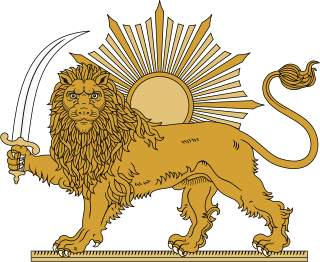
The Lion and Sun is one of the main emblems of Iran (Persia), and was an element in Iran's national flag until the 1979 revolution and is still commonly used by nationalists and opposition groups of the Islamic Republic government. The motif, which illustrates ancient and modern Iranian traditions, became a popular symbol in Iran in the 12th century. The lion and sun symbol is based largely on astronomical and astrological configurations: the ancient sign of the sun in the house of Leo, which itself is traced back to Babylonian astrology and Near Eastern traditions.

Mohammad Reza Pahlavi, commonly referred to in the Western world as Mohammad Reza Shah, or simply the Shah, was the last monarch of Iran (Persia). In 1941 he succeded his father Reza Shah and ruled the Imperial State of Iran until 1979 when the Iranian Revolution overthrew him, abolished the monarchy and established the Islamic Republic of Iran. In 1967, he took the title Shahanshah and also held several others, including Aryamehr and Bozorg Arteshtaran. He was the second and last ruling monarch of the Pahlavi dynasty. His vision of the "Great Civilization" led to his leadership over rapid industrial and military modernization, as well as economic and social reforms in Iran.

The Order of Zolfaghar is the highest military honour of Iran. It was established in 1856 as the Decoration of the Commander of the Faithful, by Naser al-Din Shah. It was given its current name in 1925, by Reza Shah. It is the pinnacle of the imperial honours system, limited to the sovereign and those who had performed outstanding acts of patriotism on behalf of Persia and Iran.

The Interim Government of Iran was the first government established in Iran after the Iranian Revolution. The regime was headed by Mehdi Bazargan, one of the members of the Freedom Movement of Iran, and formed on the order of Ayatollah Khomeini on 4 February 1979. From 4 to 11 February, Bazargan and Shapour Bakhtiar, the Shah's last Prime Minister, both claimed to be the legitimate prime minister; Bakhtiar fled on 11 February. Mehdi Bazargan was the prime minister of the interim government and introduced a seven-member cabinet on 14 February 1979. Ebrahim Yazdi was elected as the Foreign Minister.

The Imperial State of Iran, officially known in English as the Imperial State of Persia until 1935, and commonly referred to as Pahlavi Iran, was the Iranian state under the rule of the Pahlavi dynasty. The Pahlavi dynasty was created in 1925 and lasted until 1979, when it was ousted as part of the Islamic Revolution, which ended the Iranian monarchy and established the current Islamic Republic of Iran.

The Sun Throne is the imperial throne of Iran. It takes its name from a radiant sun disk on the headboard. The throne has the shape of a platform, similar to the Marble Throne in Golestan Palace. The Naderi Throne was constructed later and has the appearance of a chair. Since 1980 it has been displayed at Iran's Central Bank.

The House of Bahmani, also called Bahmani-Qajar, is an aristocratic Iranian family belonging to one of the princely families of the Qajar dynasty, the ruling house that reigned Iran 1785–1925. The founder is Bahman Mirza Qajar (1810–1884), the younger brother of Mohammad Shah Qajar and formerly prince regent and governor of Azerbaijan 1841–1848.

The Shah Mosque, also known as the Soltāni Mosque meaning "royal", renamed the Imam Mosque, after the 1979 Iranian Revolution, is a principal mosque in the northern section of the Grand Bazaar in Tehran, Iran.

